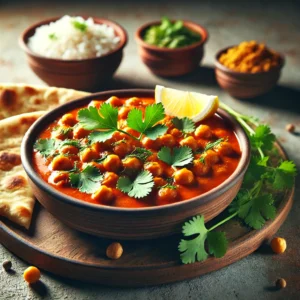Chickpeas, also known as garbanzo beans, have been an integral part of Indian cuisine for centuries. Their ability to absorb rich, aromatic spices makes them the perfect base for a variety of dishes. Among the most beloved preparations is Chickpeas in Indian Curry—a dish that not only delights the palate but also provides a wholesome, nutritious meal. This humble yet hearty dish holds a cherished place in North Indian households and has variations that traverse the length and breadth of the country.
Popularity of Chickpea Curry in North India
In North India, Chana Masala—the quintessential chickpea curry—is a staple dish, often served with steaming hot bhature (a type of fried bread), puri, or basmati rice. The dish is known for its robust, spicy, and tangy flavors, derived from a rich blend of tomatoes, onions, garlic, ginger, and warming spices like cumin, coriander, and garam masala.
In cities like Delhi and Amritsar, Chole Bhature has gained legendary status. It’s not just a meal; it’s an experience. Often enjoyed for breakfast or lunch, this pairing of spicy chickpeas and fluffy, deep-fried bread is sold in homespun eateries and five-star restaurants alike.
What makes chickpea curry so popular is its versatility. It’s a go-to dish for vegetarian households and is easily customizable to suit different taste preferences. Whether cooked dry as a side dish or as a rich, gravy-laden curry, it has the power to transform a simple meal into a feast.
Variations Across India
While North India revels in the spicy and tangy Chana Masala, other regions have their own delightful spins on chickpeas in curry:
- Punjabi Chole:
Famous in Punjab, this variation often includes black tea or amla (Indian gooseberry) to darken the curry and add a subtle tang. The spices are robust, and the dish is paired with naan or kulcha. - South Indian Sundal:
In South India, chickpeas take on a lighter flavor profile. Sundal is a stir-fried dish with coconut, curry leaves, and mustard seeds. It’s less spicy and often served as a snack or prasad (offering) during festivals. - Gujarati Chana Curry:
Gujarati cuisine brings a sweet and sour twist with the use of jaggery and tamarind. This curry is lighter on spices but high on flavor, making it a comforting dish served with rotis or rice. - Kerala Kadala Curry:
In Kerala, black chickpeas (kala chana) are simmered in a coconut-based curry spiced with fennel, cinnamon, and cloves. Paired with puttu (steamed rice cakes), it’s a breakfast classic. - Bengali Ghugni:
In Bengal, dried yellow peas or chickpeas are cooked into a tangy and slightly sweet curry, served as street food with puffed rice or as a standalone snack.
Nutritional Benefits of Chickpeas
Chickpeas aren’t just delicious; they are a powerhouse of nutrition, making them a favorite among health enthusiasts. Here’s why they deserve a place on your plate:
- High in Protein:
Chickpeas are a great plant-based protein source, making them essential for vegetarians and vegans. A cup of chickpeas provides about 15 grams of protein, supporting muscle repair and growth. - Rich in Fiber:
The high fiber content aids digestion, promotes gut health, and helps regulate blood sugar levels. It also contributes to a feeling of fullness, which can aid in weight management. - Packed with Vitamins and Minerals:
Chickpeas are rich in folate, iron, magnesium, and zinc. Folate supports brain health, while iron helps combat anemia, especially in women. - Low Glycemic Index:
Despite being carbohydrate-rich, chickpeas have a low glycemic index, making them suitable for people with diabetes. - Heart-Healthy Fats:
Chickpeas contain small amounts of unsaturated fats that are good for heart health. - Antioxidant Properties:
The presence of polyphenols, flavonoids, and other antioxidants helps fight inflammation and protects against chronic diseases.
A Dish That Bridges Tradition and Modernity
Chickpeas in curry is more than just a meal; it’s a bridge between tradition and modern culinary innovation. While its roots lie in age-old recipes handed down through generations, the dish has found a place in global kitchens, from fine-dining restaurants to cozy home kitchens.
Modern variations often experiment with ingredients like coconut milk, cashew cream, or even spinach, giving the dish a contemporary twist without compromising its essence.
Closing Thoughts
Whether you’re savoring a plate of spicy Chana Masala in Delhi (or as they say Chhole) or indulging in a coconut-laden Kadala Curry in Kerala, chickpea curry showcases the incredible diversity of Indian cuisine. Its rich flavors, wholesome nutrition, and cultural significance make it a dish worth celebrating.
So, the next time you whip up a pot of chickpea curry, remember: you’re not just cooking a meal; you’re partaking in a culinary tradition that has brought joy and nourishment to countless tables across India and beyond.

Chickpeas in Indian Curry
Equipment
- 1 Pan
Ingredients
- ½ cup Chickpeas Dried chickpeas, soaked and boiled
- 1 no. Onions Small
- 2 no. Tomatoes Medium sized, pureed
- 2 no. Garlic Cloves (लहसुन) Minced
- 1 no. Ginger (अदरक) About 1 inch long grated
- 2 tsp Vegetable Oil
- ½ tsp Cumin seeds (जीरा)
- ½ tsp Turmeric Powder (हल्दी)
- 1 tsp Dried Coriander Seeds (धनिया) Powder
- 1 tsp Garam Masala
- ½ tsp Red Chilly Powder Adjust to your taste
- ½ tsp salt Adjust to your taste
- ¼ cup Coconut Milk or cream for a creamy texture
- ½ cup water
- coriander fresh coriander leaves, chopped for garnishing
- Lemon 1 wedge for serving
Instructions
- Prepare the chickpeas: Soak dried chickpeas overnight, cook until tender, and drain. If using canned chickpeas, rinse and drain them.
- Heat oil in a pan over medium heat. Add cumin seeds and let them sizzle for about 30 seconds until fragrant.
- Sauté the aromatics: Add the chopped onion and cook until golden brown (about 5-7 minutes). Stir in the ginger and garlic, cooking for 1-2 minutes.
- Add spices: Lower the heat slightly and add turmeric, coriander powder, and red chili powder. Stir for 30 seconds to toast the spices.
- Make the base: Pour in the tomato puree and cook until the oil starts to separate from the mixture (about 5-7 minutes).
- Add chickpeas: Stir in the chickpeas, coating them in the sauce. Add water and let it simmer for 5-10 minutes until the flavors meld.
- Finish with Garam Masala and coconut milk (if using):Stir well and simmer for 2 more minutes.
- Garnish: Sprinkle fresh coriander leaves (chopped) on top and squeeze a lemon wedge over the curry before serving.
Serving Suggestions
- Serve with steamed Basmati rice, naan or roti.

